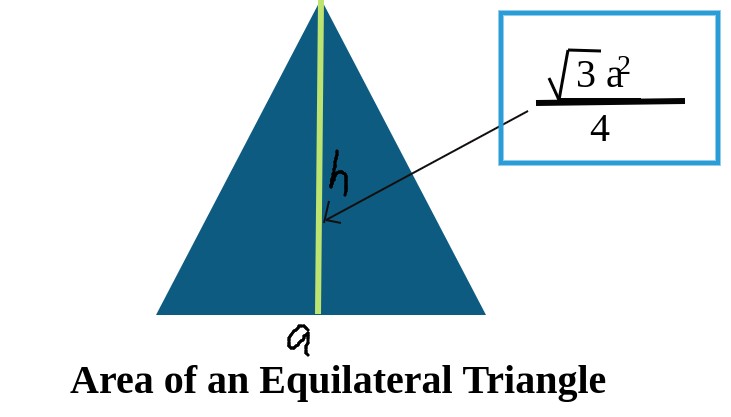Area of an equilateral is square the length of one side, multiply it by the square root of 3, and then divide the result by 4 .
The area of an equilateral triangle can be calculated using the following formula (a2 * √3) / 4 Where, “a” represents the length of one side of the equilateral triangle.
Equilateral triangles have all sides of equal length and all angles measuring 60 degrees, making their area calculation relatively straightforward.
Area of an Equilateral Triangle Formula
The formula to calculate the area of an equilateral triangle is:
Area (A) = (a2 * √3) / 4
Where:
- A represents the area of the equilateral triangle.
- a represents the length of one side of the equilateral triangle.
- √3 represents the square root of 3.
How to Find the Area of an Equilateral Triangle
To calculate the area of an equilateral triangle, follow these steps:
- Measure the length of one side of the equilateral triangle. Let’s call this length s.
- Square the length of one side:
- a2
- Multiply the squared side length by the square root of 3 (approximately 1.732):
- a2* √3
- Finally, divide the result by 4:
- (a2 * √3) / 4
Example: Let’s say you have an equilateral triangle with a side length of 6 units. To find its area:
Area (A) = (62 * √3) / 4
Area (A) = (36 * 1.732) / 4
(A) = 62.352 / 4
Area (A) = 15.588 square units
Properties of Equilateral Triangle
- All three sides have the same length.
- All three interior angles are equal and each measures 60 degrees.
- The sum of the interior angles is always 180 degrees.
- The exterior angle at each vertex is 120 degrees.
- The altitudes and medians of an equilateral triangle are the same lines.
- Equilateral triangles have 3-fold rotational symmetry.
Solved Examples on Area of Equilateral Triangle
Here are some solved examples to illustrate how to calculate the area of an equilateral triangle using the formula.
Example 1: Suppose you have an equilateral triangle with a side length of 10 centimeters. Calculate its area.
Area (A) = (102 * √3) / 4
Area (A) = (100* 1.732) / 4
(A) = 173.2 / 4
Area (A) = 173.2 cm2
FAQs
1. What is an equilateral triangle?
An equilateral triangle is a type of triangle in which all three sides are of equal length, and all three interior angles are each 60 degrees.
2. How do you calculate the area of an equilateral triangle?
You can calculate the area of an equilateral triangle using the formula: Area (A) = (a2* √3) / 4, where “a” represents the length of one side of the triangle.
3. Why is the formula for the area of an equilateral triangle different from that of other triangles?
The formula for the area of an equilateral triangle includes the square root of 3 (√3) because of its unique properties. The equilateral triangle has specific angles (60 degrees) and side relationships that lead to this formula.
4. Can I find the area of an equilateral triangle without knowing the side length?
- No, to calculate the area of an equilateral triangle, you must know the length of at least one of its sides.
5. What is the perimeter of an equilateral triangle?
The perimeter of an equilateral triangle is simply the sum of its three equal side lengths. It can be calculated as P = 3a, where “P” is the perimeter and “a” is the side length.
6. Are equilateral triangles used in real-world applications?
Yes, equilateral triangles and their properties are used in various fields such as geometry, engineering, architecture, and design. They are often employed to create stable and symmetrical structures.
7. Can equilateral triangles have different interior angles or side lengths?
No, by definition, equilateral triangles have all sides and angles of equal length and measure. Any variation in side lengths or angles would make the triangle non-equilateral.
8. What is the relationship between equilateral triangles and regular polygons?
Equilateral triangles are a type of regular polygon. Regular polygons have equal sides and equal angles, and equilateral triangles are the simplest example of this category.

